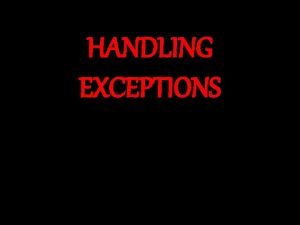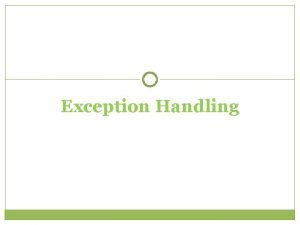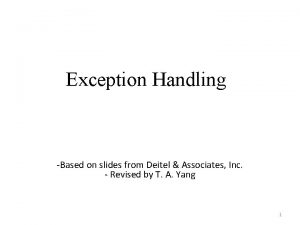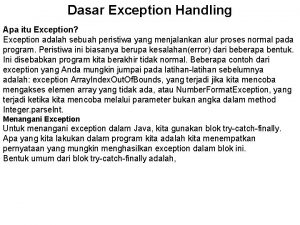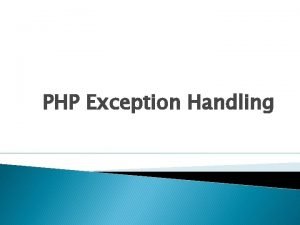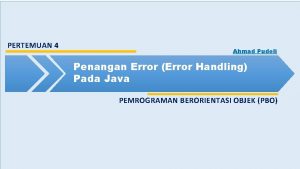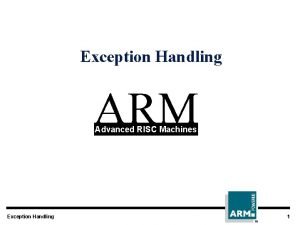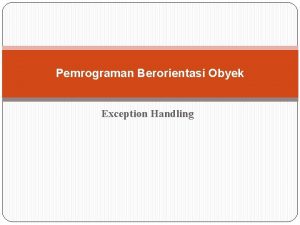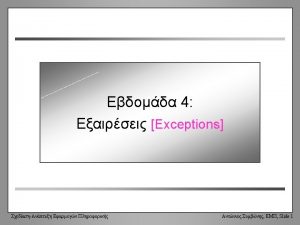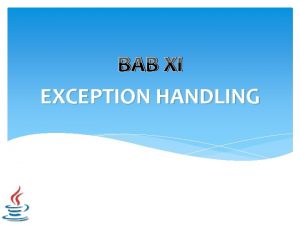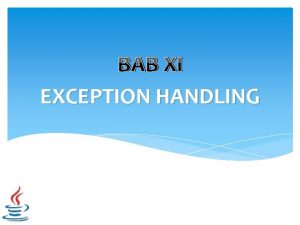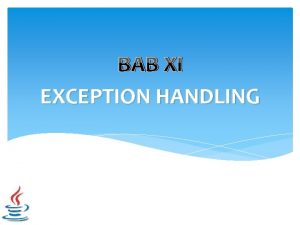Lecture 17 Exception Handling and Richard Gesick Exception











- Slides: 11

Lecture 17 Exception Handling and Richard Gesick

Exception Handling • An exception is an indication of a problem that occurs during a program’s execution. • Exception handling enables applications to resolve exceptions. • Exception handling enables clear, robust and more fault-tolerant programs. • Exception handling helps improve a program’s fault tolerance.

Exception Handling Consider the following pseudocode: Perform a task If the preceding task did not execute correctly Perform error processing Perform next task If the preceding task did not execute correctly Perform error processing … In this pseudocode, we begin by performing a task; then we test whether that task executed correctly. If not, we perform error processing.

Exception Handling • Exception handling enables programmers to remove error-handling code from the “main line” of the program’s execution. • Programmers can decide to handle all exceptions, all exceptions of a certain type or all exceptions of related types. • Such flexibility reduces the likelihood that errors will be overlooked.

try Block • A try block encloses code that might throw exceptions and code that is skipped when an exception occurs. try { open file perform work on file close file }

Catch Block • When an exception occurs in a try block, a corresponding catch block catches the exception and handles it. • At least one catch block must immediately follow a try block. • A catch block specifies an exception parameter representing the exception that the catch block can handle. • Optionally, you can include a catch block that does not specify an exception type to catch all exception types.

Catch Block catch(IO. File. Not. Found. Exception fnfe) { handle file not found (using fnfe object) } catch(Exception e) { handle other type of exception (using e object) close file }

Exception Handling- Termination Model • When a method called in a program or the CLR detects a problem, the method or the CLR throws an exception. • The point at which an exception occurs is called the throw point • If an exception occurs in a try block, program control immediately transfers to the first catch block matching the type of the thrown exception. • After the exception is handled, program control resumes after the last catch block.

finally Block • Programs frequently request and release resources dynamically. Operating systems typically prevent more than one program from manipulating a file. • Therefore, the program should close the file (i. e. , release the resource) so other programs can use it. If the file is not closed, a resource leak occurs. • The finally block is guaranteed to execute regardless of whether an exception occurs.

finally Block • Local variables in a try block cannot be accessed in the corresponding finally block, so variables that must be accessed in both should be declared before the try block.

Reminder • Do not place try blocks around every statement that might throw an exception. • It’s better to place one try block around a significant portion of code, and follow this try block with catch blocks that handle each possible exception. • Then follow the catch blocks with a single finally block. • Separate try blocks should be used when it is important to distinguish between multiple statements that can throw the same exception type.




